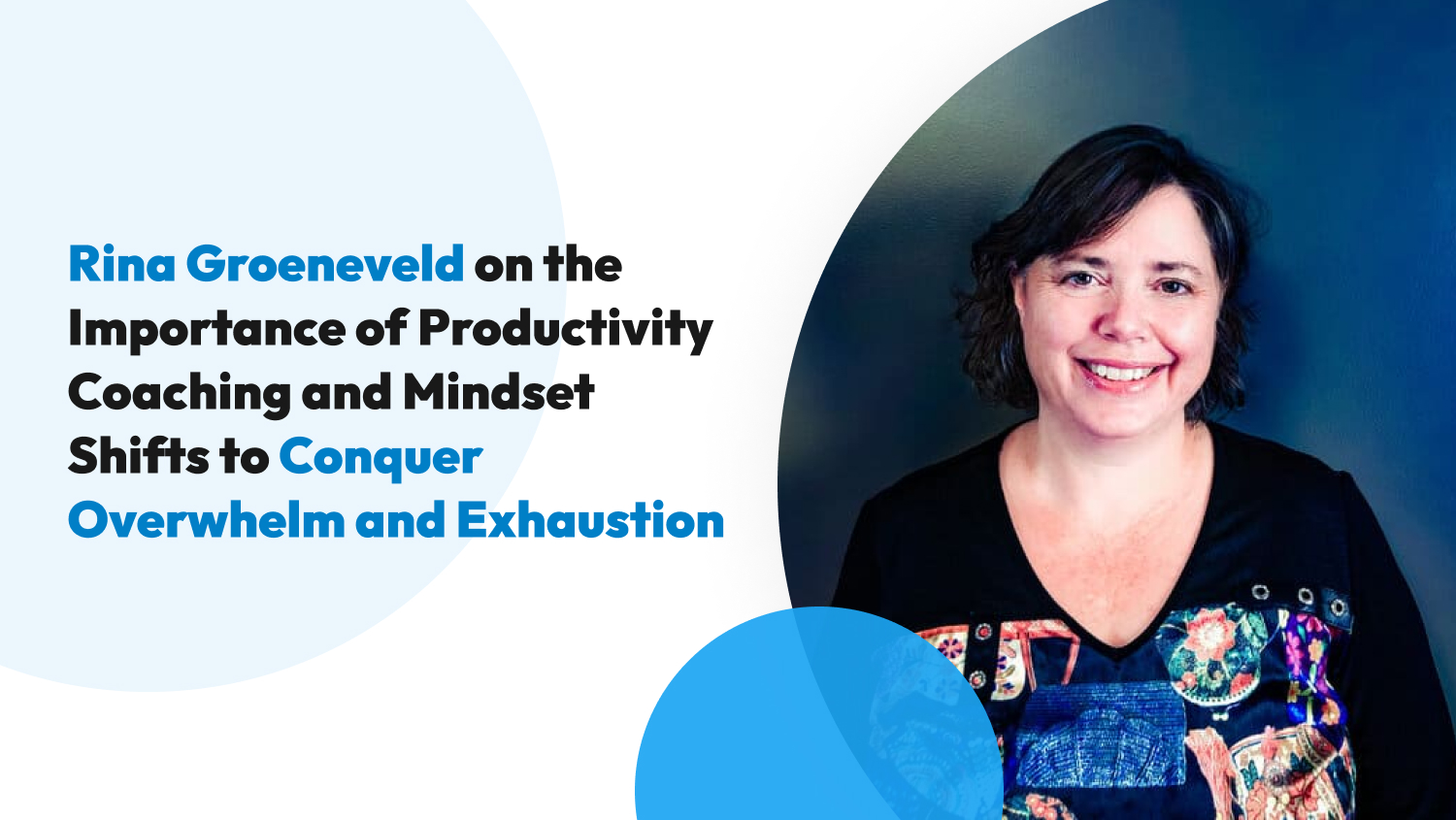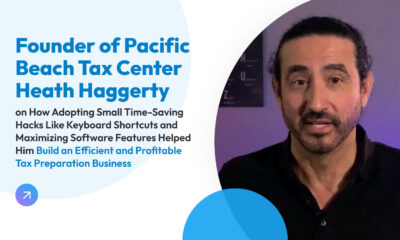Case Study
Rina Groeneveld on the Importance of Productivity Coaching and Mindset Shifts to Conquer Overwhelm and Exhaustion
Rina Groeneveld stepped into the entrepreneur role under difficult circumstances. Her marriage had ended, and she was left financially vulnerable in a country where she only had a temporary work visa. With grit and hard work, what she initially went into as a “way to help me survive” has grown into a six-figure business.
In this article, we learn about Groenveld’s unplanned journey to building a business, the challenges she overcame, and the lessons learned along the way. Check out the summary of Groeneveld’s Productivity Stack Quick Reference and her recommended reading list at the end of the article.
Table of Contents
- Starting
- Growing
- Challenge 4: Six-figures without a plan or system: Disorganized and inefficient invoicing
- Challenge 5: Shifting to a strategic mindset: Learning about increasing productivity and setting boundaries
- Challenge 6: Challenging a negative mindset and rejecting new ideas
- Challenge 7: Social media distraction
- Challenge 8: Fine-tuning her morning routine
- Scaling and Success
- Other Tools She Recommends
- Hindsight: What Groeneveld would have done differently
- Wrap-up
- Groeneveld Read-Listen List
- Groeneveld’s Productivity Stack Quick Reference
- More About Rina Groeneveld
Starting
Challenge 1: Starting from zero
When Groeneveld’s marriage of over 20 years ended, she was left to raise and provide for her four children by herself. She worked two minimum-wage jobs and decided to do translation work on the side to add to her income. She translated German, Dutch, or French texts into English. “I really enjoyed that. I knew I was good at it and that it was something I had a gift for.”
But she didn’t have any plans of starting a business and admits, “My first choice back then would have been to get a job as an employee.” It was a slow start trying to get translation jobs. She had no clients and didn’t know how to market her services.
Solution: Groeneveld registered on a translation jobs portal and started getting several jobs there. For someone starting in the translation business and juggling two other jobs, this provided her with a simple way to find clients who needed her services.
People: Groeneveld
Systems: Applying for translation jobs
Tools: Translation Job Portal
Challenge 2: Financial struggles
While joining the translation job portal got her foot in the door, making a sustainable living did not quickly come her way. Her combined income from her two minimum wage jobs plus translation work amounted to just CAD6,000 for a year. She even got scammed by her first client, who didn’t pay for translation work worth a couple of thousands of euros. “It nearly stopped me from becoming a translator.”
Then another complication set in. Groeneveld had moved to Canada with her family in 2010 and was not yet a permanent resident. When her work permit expired in January 2015, she could no longer legally keep her two local jobs. She needed to find a way to make a living legally as a visitor in Canada.
Solution: Groeneveld focused on turning her translation side hustle into her main business, and Grow Your Business In English was born. Her clients were mostly based in Europe, so this was something she could continue on her visitor visa. “I was basically pushed into deep water from a very high cliff. I just dived in and made the best of it.”
People: Groeneveld
Systems: Doubling down on what was formerly a side hustle to transform it into her main source of income
Tools: Translation Job Portal, email like Outlook to track jobs
Challenge 3: Getting very low rates
Groeneveld took on more jobs through the translation jobs portal, but she struggled with the low rates. “I went in at the bottom of the industry, and the famous bottom feeder agencies were the ones that found me on the portal originally. Apparently, the owner of the first agency that paid me used to say, ‘Well, give [the job to Rina], she’ll take anything.'”
Solution: Groeneveld’s ability to charge better rates came with time, experience, and ability to build up her client base. She took a generalist approach to her translation business instead of finding a niche industry right off the bat. This approach helped her gain a lot of experience and hone her translation skills. She shares, “I got so much experience from such a wide variety and huge volume of texts. It helped me improve the quality of my work as time went on.”
The jobs portal was her primary form of distribution, but as she proved herself in the business, she soon started getting referrals from former clients. With more clients, she was able to raise her rates bit by bit and stop working for the agencies that couldn’t give her a decent rate.
People: Groeneveld, former clients/contacts
Systems: Generalist approach to translation work to gain experience and get more opportunities, referral system from former clients and connections in the industry
Tools: Translation Job Portal, email like Outlook to track jobs
Growing
Challenge 4: Six-figures without a plan or system: Disorganized and inefficient invoicing
With her tenacity and hard work, Groeneveld grew her translation hustle to a six-figure business. Yet, at this point, working as a solopreneur, she still had no system and tools to help her get more things done efficiently.
With a lot of her time and energy focused on the translation jobs, even the important task of invoicing was left on low priority and done manually. She used email and Excel spreadsheets to track jobs and Word to create invoices. She ended up falling many months and even years behind on sending out her invoices. “I’ve had clients come back to me to send them invoices because they need to close their tax year.”
Solution: Groeneveld started using an automated tool for linguistic service providers called LSP. This tool helps track jobs and invoice details, such as rates for different clients, number of words, job statuses, and job categories. With the built-in invoicing system, what would take her a day to finish with her old tools now takes her half an hour with LSP.
People: Groeneveld
Systems: Investment in LSP software
Challenge 5: Shifting to a strategic mindset: Learning about increasing productivity and setting boundaries
Groeneveld was not quick to adopt tools and systems to help with her business, though. She had many years where she felt unproductive and scattered, even though she had a lot of work coming in. “I was making six figures, but I was incredibly overwhelmed.” She was working 15-hour days, all-nighters, and weekends. She needed help setting up systems for her business, setting boundaries, and learning to say no.
Solution: She enrolled in Success by Rx, a coaching program run by Jenae Spry, tailored for translators. The program introduced her to productivity concepts, systems, and tools. She implemented a few of them and actually started earning more because of the productivity boost. But her schedule remained full-packed, and she still hadn’t learned to turn down jobs beyond her capacity.
Then a few things happened that helped nudge her along in her productivity journey. First, she enrolled in a part-time university course that forced her to leave work two to three times a week. Her calendar was always so full she had no choice but to say no to some jobs. Second, when the pandemic lockdowns came along, the volume of translation work slowed down.
With free time on her hands all of a sudden, she decided to dive deeper into productivity coaching and self-improvement. She started to actively participate in the Success by Rx Program, which by then had rebranded to the Accelerator Program of the Doer Entrepreneurs Inner Circle. She joined activity sprints, book clubs, and live Q&A sessions. She discovered she could listen to books on Audible and started listening to business and marketing books.
She shares, “Up to that point, I had never read a single business book or marketing book. I just stumbled through, blindly doing my translations, doing everything that was delivered to me and giving it back and just getting through my day.”
The slowdown brought by the pandemic gave her the opportunity to step back and think about her business as more than just a series of jobs she had to complete.
People: Groeneveld, Jenae Spry of Doer Entrepreneurs, group coaching peers
Systems: Connecting and consulting with productivity and performance coach, joining group coaching activities like “Procrastination to Productivity Master” sprint, book clubs, coworking, and “Office Hours” live Q&A Sessions
Tools: Facebook, productivity courses/coaching groups, Zoom for coworking, Audible
Challenge 6: Challenging a negative mindset and rejecting new ideas
By this point, Groeneveld felt like productivity concepts were “on the horizon” – she had become aware of them but wasn’t really taking them to heart. She was consuming a lot of content on the subject through the coaching activities and the audiobooks, but she was still resistant to a lot of the ideas. Her reaction to the notion of time blocking was, “Oh no, I can’t do that. That’s not for me.”
Solution: Fortunately, after several coaching sessions, Groeneveld was persuaded by the suggestion, “Just experiment. If you don’t like it, you can always stop it.”
She went all-in on time blocking for a few months. At some point, she fell off the wagon, and it was then that she realized how beneficial the system was for her. Without time blocking, she felt burnt out, and the quality of her work suffered. She recalls, “I realized the benefits of it; the difference that it makes. I think sometimes, there’s nothing wrong with starting a habit and then falling off the wagon for a while and then realizing how you feel when you’re off the wagon.”
Groeneveld admits she still occasionally slips up with her time blocking, but the majority of the time, she puts the system to use. It was quite a breakthrough for her to experience firsthand how much less stressful her life can be with time blocking, quite the opposite of her initial impression that it would be too restrictive and hinder her flexibility in getting work done.
People: Groeneveld, Jenae Spry of Doer Entrepreneurs
Systems: Time blocking, consultations with productivity and performance coach, testing new systems
Tools: Zoom for coaching sessions, Google Calendar for time blocking
Challenge 7: Social media distraction
Groeneveld also highlighted how social media was a significant challenge for her. Whenever she got to difficult or boring parts of a translation job, she found herself turning to Facebook or Twitter.
She shares, “I realize now maybe I needed some dopamine. And the next thing I know, I’d be down the rabbit hole, and the time block would have whooshed by without me doing more than 45 minutes on the job.” Her social media distraction was one reason she doubted the time-blocking system.
Solution: Her breakthrough in how to deal with social media distraction came from reading Marie Forleo’s “Everything is Figureoutable,” a book about finding creative solutions to things that are holding you back.
Groeneveld says, “I looked at this bit about ‘social media fast,’ and I thought, no, I couldn’t just give up social media for two weeks. That’s nuts. But I thought, you know what I can do? I can make a mini social media fast every day. I can make it so that I do not look at social media before midday. And so that’s what I started doing.”
Groeneveld’s modified social media fast worked very well. She was able to stick with it because she knew she could open Facebook or Twitter later in the day and didn’t feel severely restricted. At the same time, those few morning hours of completely detaching from social media made her realize how automatic her social media habit had become. With this newfound awareness of her unproductive tendency, she began to catch herself before she started doom-scrolling or jumping in on arguments in the comments sections.
Today, when she comes across something challenging in a translation job, she doesn’t quickly give in to the temptation. “I would just take a breath, and I would keep at it, instead of letting myself get distracted with a dopamine hit.” And she noticed that her desire for social media has actually gone down as well – an unexpected side effect of her mini fasts.
People: Groeneveld
Systems: Time blocking, social media fasts
Tools: Google Calendar, Everything is Figureoutable by Marie Forleo
Challenge 8: Fine-tuning her morning routine
Groeneveld learned the importance of a great morning routine from her productivity coaching group and sought ways to improve hers. She wanted to include simple tasks like flossing and working out.
Solution: She learned about habit stacking from James Clear’s book, Atomic Habits. Habit stacking is a way to introduce a new behavior into your routines by adding it to an existing habit. The reasoning behind this is if you stack a new habit on top of something already automatic and ingrained in you, this new habit will take less effort to implement.
Groeneveld figured out a way to implement it in her own morning routine. She was terrible at flossing daily but had a solid habit of putting on her Fitbit after her morning shower. So she stacked flossing onto this routine – after her shower, she flosses and then puts on her Fitbit. “And slowly from that, I started building up a morning routine, which includes working out.”
She now considers her morning routine as one of her time blocks, one that sets her day but still allows flexibility to adjust depending on what’s going on in her life. For example, she would skip a morning workout if she had an early meeting or work commitment and instead would go for an afternoon walk. “I’m still working on it, it’s something that I tweak all the time. And I fall off the wagon a lot. But at least there’s a wagon to fall off, you know?”
People: Groeneveld
Systems: Time blocking, Habit stacking
Tools: Google Calendar, Atomic Habits by James Clear
Scaling & Success
Challenge 9: Beginnings of outsourcing
Groeneveld remembers learning from her productivity coaching sessions that you can scale by hiring, farming out work, or using tools and systems. For most of the eight years of her translation business, she worked as a solopreneur. She adopted tools like LSP and systems like time blocking and social media fasts but remained a solo operation.
However, the volume of work she was getting continued to be taxing. She looked into getting more help so that she could maintain or even improve the quality of her work.
Solution: In late 2021, she made her first move to outsource by farming out some translation jobs to her son. This improved the quality of her output since she could proofread her son’s work with a fresh set of eyes compared to if she had done the translation work herself. This setup also freed up time for Groeneveld to focus on other aspects of her business.
Now that she is venturing into a second business as a divorce coach, an extra pair of hands for “Grow Your Business In English” was an important step in scaling up.
People: Groeneveld, her son
Systems: Outsourcing
Tools: LSP to track jobs allocated to son
Other Tools She Recommends
Groeneveld gave a quick rundown of other tools she uses.
One of her favorites is ClickUp, where you can create a workspace to organize any aspect of your life. Groeneveld has one workspace each for her translation business, her new high-conflict divorce coach business, and personal matters like her finances. She had previously tried the You Need a Budget (YNAB) app, couldn’t get the hang of it, and realized she could just use ClickUp. This tool is also useful for content creation and saving LinkedIn posts.
She uses AuthoredUp to proofread, preview and edit her content for LinkedIn. After taking an online site-building course, she built her translation and coaching business websites on WordPress. Last on her list is Loom, which Groeneveld likes to use for creating standard operating procedures (SOPs). She records a video while executing a task, reviews it later, and writes down the steps. She thinks the ability to observe how you do things from a third-person point of view is helpful in auditing and improving your processes.
Hindsight: What Groeneveld would have done differently
Groeneveld spent the first few years in business disorganized, distracted, and feeling quite unproductive. When asked what she would have done differently, she shares her own experience as a solopreneur who didn’t prioritize putting in place systems and tools for productivity. “Knowing what I know now, I would have found a coach, but a productivity coach first. Once you’ve worked out productivity, then you can work out other stuff.”
Wrap-up
Groeneveld building a six-figure business under very trying personal circumstances was a remarkable feat. But her transition from task-focused solopreneur firefighting every day to adopting a more strategic business owner mindset is another achievement in itself. Finding a productivity coaching program and accountability partners in her coaching group was key to changing how she runs her business. Coaching has also introduced her to the importance of dedicating time to self-development, examining habits, mental frameworks, and trying new ways of doing things.
Today, Groeneveld is branching out into another field which is very important to her. She has obtained her certification as a high-conflict divorce coach, offering support to individuals coming out of abusive relationships. We wish her the best in this new venture and look forward to her website launch very soon.
Groeneveld Read-Listen List
- Everything is Figureoutable by Marie Forleo
- Atomic Habits by James Clear
- Loving What Is by Byron Katie
- I Will Teach You To Be Rich Podcast by Ramit Sethi
- The Tools by Phil Stutz and Barry Michels
- Hooked and Indistractable by Nir Eyal
Groeneveld’s Productivity Stack Quick Reference
Starting Stack
Growing Stack
Scaling & Success Stack
More About Rina Groeneveld
After growing up in South Africa and bringing up her four children as a stay-at-home mother in four other countries, Rina Groeneveld moved to Canada in 2010.
The subsequent dissolution of her marriage of more than two decades, leaving her as the sole financial provider for herself and her children, forced Rina to find (legal) ways to bring in money. Luckily, she completed a Master’s degree in translation studies shortly before moving to Canada, so she started taking on translation work in addition to the two minimum-wage jobs she held.
When her Canadian work permit expired in early 2015, Rina turned to translation as her sole source of income so she could stay in Canada with her new partner. Eight years later, she’s a Canadian citizen and the owner of a flourishing translation business. She’s also busy achieving her ambition to empower victims of post-separation abuse by establishing herself as a certified high-conflict divorce coach.
You can get in touch with her on:
Website: https://growyourbusinessinenglish.com/
Instagram: https://www.instagram.com/grow_your_business_in_english/
https://www.instagram.com/flourishing_after_abuse/
LinkedIn: https://www.linkedin.com/in/rina-groeneveld-232a9994/












